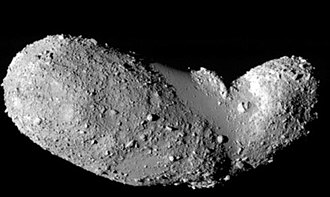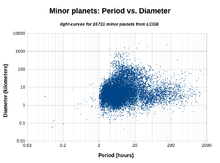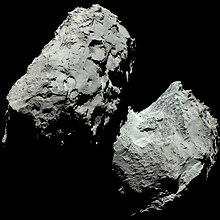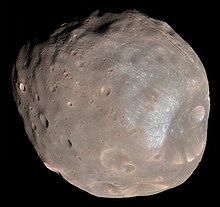
An asteroid is a minor planet—an object that is neither a true planet nor a comet—that orbits within the inner Solar System. They are rocky, metallic, or icy bodies with no atmosphere. The size and shape of asteroids vary significantly, ranging from small rubble piles under a kilometer across to Ceres, a dwarf planet almost 1000 km in diameter.
Comet Shoemaker–Levy 9 broke apart in July 1992 and collided with Jupiter in July 1994, providing the first direct observation of an extraterrestrial collision of Solar System objects. This generated a large amount of coverage in the popular media, and the comet was closely observed by astronomers worldwide. The collision provided new information about Jupiter and highlighted its possible role in reducing space debris in the inner Solar System.

4179 Toutatis is an elongated, stony asteroid and slow rotator, classified as a near-Earth object and potentially hazardous asteroid of the Apollo asteroid group, approximately 2.5 kilometers in diameter. Discovered by French astronomer Christian Pollas at Caussols in 1989, the asteroid was named after Toutatis from Celtic mythology.

The asteroid belt is a torus-shaped region in the Solar System, centered on the Sun and roughly spanning the space between the orbits of the planets Jupiter and Mars. It contains a great many solid, irregularly shaped bodies called asteroids or minor planets. The identified objects are of many sizes, but much smaller than planets, and, on average, are about one million kilometers apart. This asteroid belt is also called the main asteroid belt or main belt to distinguish it from other asteroid populations in the Solar System.

Phobos is the innermost and larger of the two natural satellites of Mars, the other being Deimos. The two moons were discovered in 1877 by American astronomer Asaph Hall. It is named after Phobos, the Greek god of fear and panic, who is the son of Ares (Mars) and twin brother of Deimos.

In celestial mechanics, the Roche limit, also called Roche radius, is the distance from a celestial body within which a second celestial body, held together only by its own force of gravity, will disintegrate because the first body's tidal forces exceed the second body's self-gravitation. Inside the Roche limit, orbiting material disperses and forms rings, whereas outside the limit, material tends to coalesce. The Roche radius depends on the radius of the first body and on the ratio of the bodies' densities.

Asteroid impact avoidance comprises the methods by which near-Earth objects (NEO) on a potential collision course with Earth could be diverted away, preventing destructive impact events. An impact by a sufficiently large asteroid or other NEOs would cause, depending on its impact location, massive tsunamis or multiple firestorms, and an impact winter caused by the sunlight-blocking effect of large quantities of pulverized rock dust and other debris placed into the stratosphere. A collision 66 million years ago between the Earth and an object approximately 10 kilometres wide is thought to have produced the Chicxulub crater and triggered the Cretaceous–Paleogene extinction event that is understood by the scientific community to have caused the extinction of all non-avian dinosaurs.

25143 Itokawa (provisional designation 1998 SF36) is a sub-kilometer near-Earth object of the Apollo group and a potentially hazardous asteroid. It was discovered by the LINEAR program in 1998 and later named after Japanese rocket engineer Hideo Itokawa. The peanut-shaped S-type asteroid has a rotation period of 12.1 hours and measures approximately 330 meters (1,100 feet) in diameter. Due to its low density and high porosity, Itokawa is considered to be a rubble pile, consisting of numerous boulders of different sizes rather than of a single solid body.

In astrophysics, accretion is the accumulation of particles into a massive object by gravitationally attracting more matter, typically gaseous matter, into an accretion disk. Most astronomical objects, such as galaxies, stars, and planets, are formed by accretion processes.

The nucleus is the solid, central part of a comet, formerly termed a dirty snowball or an icy dirtball. A cometary nucleus is composed of rock, dust, and frozen gases. When heated by the Sun, the gases sublime and produce an atmosphere surrounding the nucleus known as the coma. The force exerted on the coma by the Sun's radiation pressure and solar wind cause an enormous tail to form, which points away from the Sun. A typical comet nucleus has an albedo of 0.04. This is blacker than coal, and may be caused by a covering of dust.

There is evidence that the formation of the Solar System began about 4.6 billion years ago with the gravitational collapse of a small part of a giant molecular cloud. Most of the collapsing mass collected in the center, forming the Sun, while the rest flattened into a protoplanetary disk out of which the planets, moons, asteroids, and other small Solar System bodies formed.

A contact binary is a small Solar System body, such as a minor planet or comet, that is composed of two bodies that have gravitated toward each other until they touch, resulting in a bilobated, peanut-like overall shape. Contact binaries are distinct from true binary systems such as binary asteroids where both components are separated. The term is also used for stellar contact binaries.

According to the International Astronomical Union (IAU), a minor planet is an astronomical object in direct orbit around the Sun that is exclusively classified as neither a planet nor a comet. Before 2006, the IAU officially used the term minor planet, but that year's meeting reclassified minor planets and comets into dwarf planets and small Solar System bodies (SSSBs).
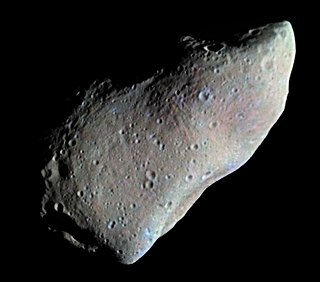
951 Gaspra is an S-type asteroid that orbits very close to the inner edge of the asteroid belt. Gaspra was discovered by Russian astronomer G. N. Neujmin in 1916. Neujmin named it after Gaspra, a Black Sea retreat that was visited by his contemporaries, such as Gorky and Tolstoy.

101955 Bennu (provisional designation 1999 RQ36) is a carbonaceous asteroid in the Apollo group discovered by the LINEAR Project on 11 September 1999. It is a potentially hazardous object that is listed on the Sentry Risk Table and has the highest cumulative rating on the Palermo Technical Impact Hazard Scale. It has a cumulative 1-in-1,750 chance of impacting Earth between 2178 and 2290 with the greatest risk being on 24 September 2182. It is named after Bennu, the ancient Egyptian mythological bird associated with the Sun, creation, and rebirth.

An extinct comet is a comet that has expelled most of its volatile ice and has little left to form a tail and coma. In a dormant comet, rather than being depleted, any remaining volatile components have been sealed beneath an inactive surface layer.

The Late Heavy Bombardment (LHB), or lunar cataclysm, is a hypothesized astronomical event thought to have occurred approximately 4.1 to 3.8 billion years (Ga) ago, at a time corresponding to the Neohadean and Eoarchean eras on Earth. According to the hypothesis, during this interval, a disproportionately large number of asteroids and comets collided into the terrestrial planets and their natural satellites of the inner Solar System, including Mercury, Venus, Earth and Mars. These came from both post-accretion and planetary instability-driven populations of impactors. Although it used to be widely accepted, it remained difficult to provide an overwhelming amount of evidence for the hypothesis. However, recent re-appraisal of the cosmo-chemical constraints indicates that there was likely no late spike in the bombardment rate.

A planetary surface is where the solid or liquid material of certain types of astronomical objects contacts the atmosphere or outer space. Planetary surfaces are found on solid objects of planetary mass, including terrestrial planets, dwarf planets, natural satellites, planetesimals and many other small Solar System bodies (SSSBs). The study of planetary surfaces is a field of planetary geology known as surface geology, but also a focus on a number of fields including planetary cartography, topography, geomorphology, atmospheric sciences, and astronomy. Land is the term given to non-liquid planetary surfaces. The term landing is used to describe the collision of an object with a planetary surface and is usually at a velocity in which the object can remain intact and remain attached.

(341843) 2008 EV5, provisional designation 2008 EV5, is a sub-kilometer asteroid, classified as a near-Earth object and potentially hazardous asteroid of the Aten group, approximately 400 metres (1,300 feet) in diameter. It was discovered on 4 March 2008, by astronomers of the Mount Lemmon Survey at Mount Lemmon Observatory near Tucson, Arizona, United States.
